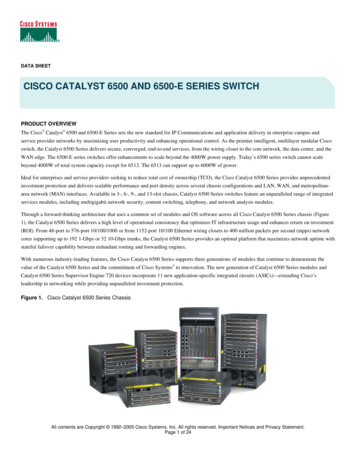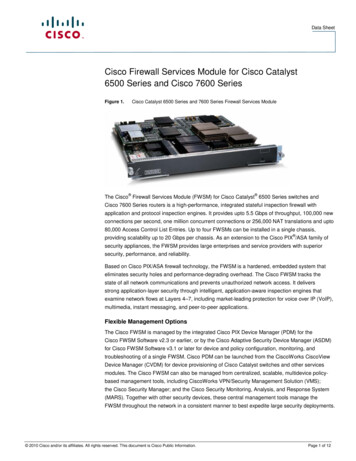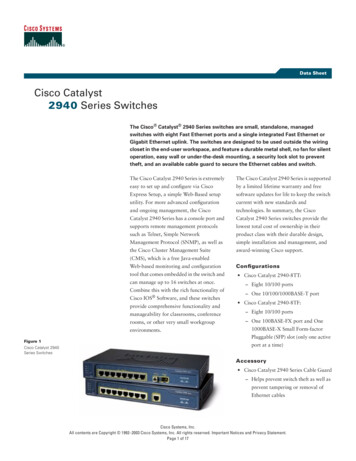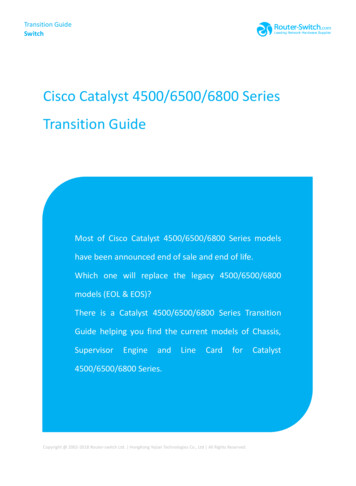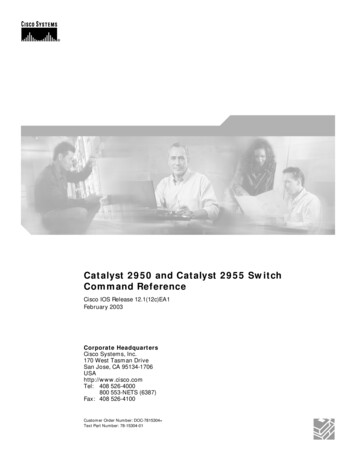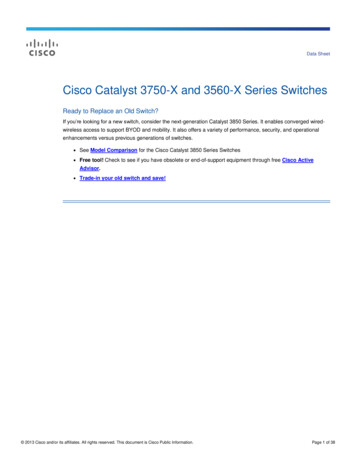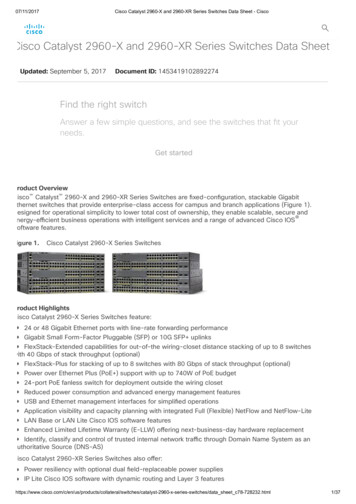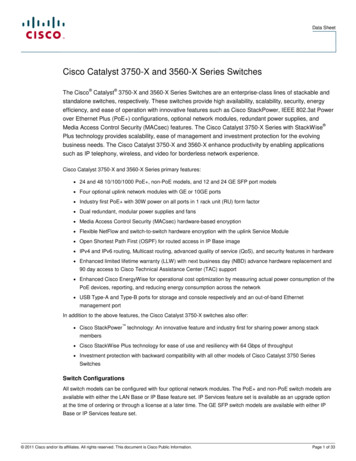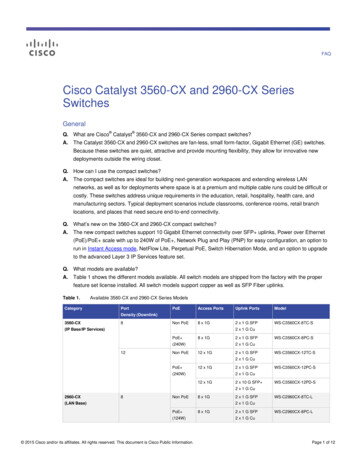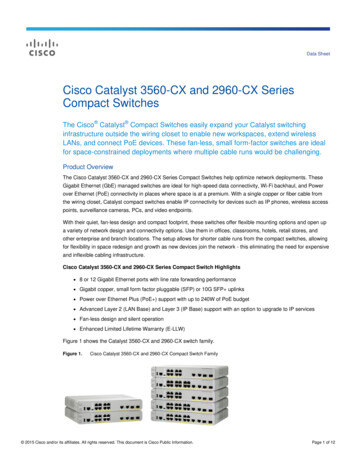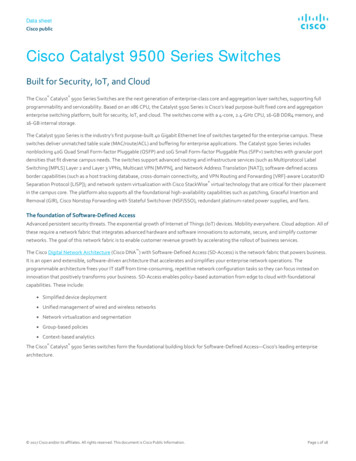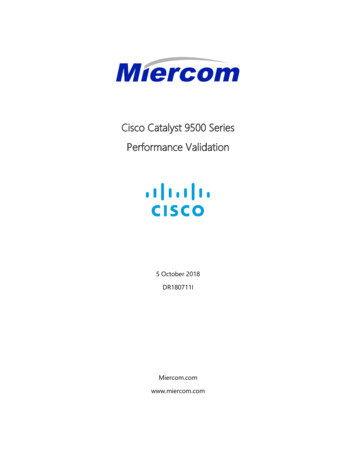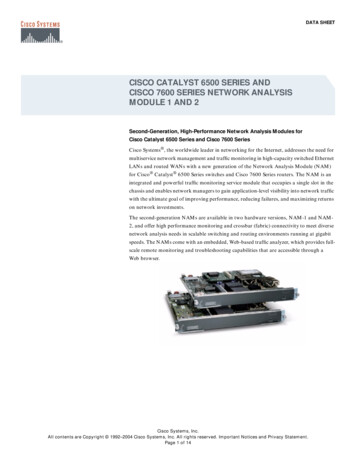
Transcription
DATA SHEETCISCO CATALYST 6500 SERIES ANDCISCO 7600 SERIES NETWORK ANALYSISMODULE 1 AND 2Second-Generation, High-Performance Network Analysis Modules forCisco Catalyst 6500 Series and Cisco 7600 SeriesCisco Systems , the worldwide leader in networking for the Internet, addresses the need formultiservice network management and traffic monitoring in high-capacity switched EthernetLANs and routed WANs with a new generation of the Network Analysis Module (NAM)for Cisco Catalyst 6500 Series switches and Cisco 7600 Series routers. The NAM is anintegrated and powerful traffic monitoring service module that occupies a single slot in thechassis and enables network managers to gain application-level visibility into network trafficwith the ultimate goal of improving performance, reducing failures, and maximizing returnson network investments.The second-generation NAMs are available in two hardware versions, NAM-1 and NAM2, and offer high performance monitoring and crossbar (fabric) connectivity to meet diversenetwork analysis needs in scalable switching and routing environments running at gigabitspeeds. The NAMs come with an embedded, Web-based traffic analyzer, which provides fullscale remote monitoring and troubleshooting capabilities that are accessible through aWeb browser.Cisco Systems, Inc.All contents are Copyright 1992–2004 Cisco Systems, Inc. All rights reserved. Important Notices and Privacy Statement.Page 1 of 14
APPLICATION-LEVEL VISIBILITY BUILT INTO THE NETWORKThe NAMs give network managers visibility into all layers of network traffic by providing application-level RemoteMonitoring (RMON) functions based on RMON2 and other advanced Management Information Bases (MIBs).The NAMs add to the built-in Remote Monitoring (mini-RMON) features in Cisco Catalyst 6500 Series switchesand Cisco 7600 Series routers that provide port-level traffic statistics at the Media Access Control (MAC) or datalink layer. The NAMs provide intelligence to analyze traffic flows for applications, hosts, conversations, andnetwork-based services such as quality of service (QoS) and voice over IP (VoIP).Integrated Monitoring for LANs and WANsThe NAMS use several data sources from local and remote switches and routers to provide combined visibilityinto LAN and WAN environments. The NAMs collect data from physical ports, virtual LANs (VLANs), orCisco EtherChannel connections using the Switch Port Analyzer (SPAN) feature. For selective monitoring of largeamount of traffic or for traffic from WAN interfaces, VLAN access control list (VACL)-based captures can be usedto filter traffic before it is sent to NAM. In addition, the NAMs collect and analyze NetFlow Data Export from localand remote devices to provide broad application-level visibility into the network, including remote WAN segments.The NAMs also collect data from remote switches using the remote SPAN (RSPAN) feature of the CiscoCatalyst switches.FLEXIBLE DEPLOYMENT SCENARIOSThe NAMs can be deployed in the Cisco Catalyst 6500 Series at LAN aggregation points (for example, in the coreor distribution layer) for proactive monitoring; at service points (for example, in data centers, server farms, orCisco CallManager clusters in IP telephony networks) where performance is critical; and at important access points(critical clients, IP phone closets) where quick troubleshooting is required. They can also be deployed in Cisco 7600Series routers at WAN edges or in Catalyst 6500 Series switches connected to WAN routers. When deployed atremote branch offices, the NAMs provide unique advantage to perform remote troubleshooting and traffic analysisthrough its Web-based Traffic Analyzer without having to send personnel or to haul large amounts of data to thecentral site. Figure 1 highlights the deployment of NAMs to enable comprehensive traffic monitoring and analysisfor performance monitoring, troubleshooting, and capacity planning.Cisco Systems, Inc.All contents are Copyright 1992–2004 Cisco Systems, Inc. All rights reserved. Important Notices and Privacy Statement.Page 2 of 14
Figure 1Web Deploying NAMs to Build Intelligence into the Network to serve a Variety of ApplicationsBranch OfficeRemote Troubleshootingand PerformanceMonitoringNAMWANNAMNAMNetFlow Data Exportto Remote NAMWAN EdgeApplicationUtilization for Localand Remote WAN tical ClientsDistributionTraffic UtilizationMonitoring andTroubleshootingCoreData CenterApplicationPerformanceMonitoringEASY TO DEPLOY AND USEThe NAMs come with the embedded, Web-based Traffic Analyzer with extensive monitoring and troubleshootingcapabilities. Because the NAMs integrate monitoring functions directly into the switch and have complete datacollection and data analysis capabilities on board, they are easy to deploy and managers can conveniently access datafrom anywhere using a Web browser (Figure 2). For security, users can be given role-based access and the Webbrowser access can be secured with up to 168-bit encryption.Cisco Systems, Inc.All contents are Copyright 1992–2004 Cisco Systems, Inc. All rights reserved. Important Notices and Privacy Statement.Page 3 of 14
Figure 2Web-Based Traffic Monitoring for both LAN and WAN with the embedded NAM Traffic AnalyzerThe NAMs also provide the flexibility to use standards-based external applications using the Simple NetworkManagement Protocol (SNMP). NetScout nGenius Real-Time Monitor, a component of the CiscoWorks LANManagement Solution (LMS), collects data from NAMs across the network and provides reports on traffic flow.MAJOR BENEFITS Increase return on network investment—The visibility provided by the NAMs enables better utilization ofnetwork resources to meet business objectives. They ease deployment of network-based services and helpin capacity planning. Reduce productivity loss and revenue loss—Through proactive monitoring and quick troubleshootingcapabilities, the NAMs prevent loss due to network degradation and downtime. Enhance network security—The NAMs provide investigation and verification capabilities to supplement othersecurity mechanisms such as intrusion detection and firewalls. They can also be used to detect threats by watchinganomalies in the network traffic.Cisco Systems, Inc.All contents are Copyright 1992–2004 Cisco Systems, Inc. All rights reserved. Important Notices and Privacy Statement.Page 4 of 14
FEATURES AND APPLICATIONSThe data collected by the NAMs can be used for several vital management activities, including real-time andhistorical application monitoring, performance management, fault isolation, troubleshooting, and capacity planning.The NAMs also play an active role in managing differentiated services such as voice.Real-Time and Historical Application MonitoringUsing RMON, RMON2, several extended RMON MIBs, and NetFlow, the NAMs detect the applications onthe network and provide detailed real-time and historical information about how these applications utilize thebandwidth, which hosts access those applications, and which client/server pairs generate the most traffic (Figure 3Aand 3B).Figure 3AMonitoring Applications and Hosts on the NetworkCisco Systems, Inc.All contents are Copyright 1992–2004 Cisco Systems, Inc. All rights reserved. Important Notices and Privacy Statement.Page 5 of 14
Figure 3BMonitoring Application Utilization on a WAN link using NetFlow Data Export from a Remote RouterPERFORMANCE MANAGEMENTThe NAMs provide valuable information about the delays in server responses to client requests. Using theApplication Response Time (ART) MIB, developed by Cisco partner NetScout Systems, the NAMs can identifyproblems with applications or servers in critical environments such as e-commerce and IP telephony (Figure 4).Cisco Systems, Inc.All contents are Copyright 1992–2004 Cisco Systems, Inc. All rights reserved. Important Notices and Privacy Statement.Page 6 of 14
Figure 4Application Response Time MonitoringFault Isolation and TroubleshootingUsing the NAMs, network managers can set thresholds and alarms on various network parameters such as increasedutilization, severe application response delays, and voice quality degradation, and be alerted to potential problems.The NAMs provide comprehensive views on applications, hosts, voice, quality of service (QoS), and so on, to isolatefaults or malfunctions in the network. The NAM Traffic Analyzer can capture and decode packets in real time to aidtroubleshooting (Figure 5).Cisco Systems, Inc.All contents are Copyright 1992–2004 Cisco Systems, Inc. All rights reserved. Important Notices and Privacy Statement.Page 7 of 14
Figure 5Capturing and Decoding Packets with NAMVoIP and QoS MonitoringThe NAMs can analyze voice traffic flows in real time to collect valuable information, including call setup detailsand voice quality metrics. Network managers can be alerted to voice quality degradation and can isolate potentialproblems (Figure 6).The NAMs make the deployment of QoS for voice and other critical services effective by identifying violations ofQoS policies. The NAMs support the Differentiated Services Monitoring (DSMON) MIB, which monitors trafficby differentiated services code point (DSCP) allocations defined by QoS policies (Figure 7).Cisco Systems, Inc.All contents are Copyright 1992–2004 Cisco Systems, Inc. All rights reserved. Important Notices and Privacy Statement.Page 8 of 14
Figure 6IP Telephony MonitoringFigure 7QoS Monitoring Using DSMONCisco Systems, Inc.All contents are Copyright 1992–2004 Cisco Systems, Inc. All rights reserved. Important Notices and Privacy Statement.Page 9 of 14
Capacity Planning and Other Extended ApplicationsThe data from the NAMs across the network can be collected by NetScout nGenius Real-Time Monitor, a componentof the CiscoWorks LAN Management Solution (LMS) to provide consolidated views of network traffic (Figure 8).The NAMs serve as data sources for several other standards-based applications for a variety of purposes includingcapacity planning, long-term historical reporting and trending, anomaly-based threat detection, etc.Figure 8Aggregating data from NAMs across the network using NetScout nGenius Real-Time MonitorPRIMARY ADVANTAGES Integrated with network infrastructure—The NAMs occupy a single slot within the Cisco Catalyst 6500 Seriesor Cisco 7600 Series chassis and are deployed, managed, and supported as an integral part of the networkinfrastructure. They do not interfere with switching and routing functions and have their own processingresources. They are managed as a part of the network device using CiscoWorks management tools. Complete monitoring solution for LAN, WAN, and network-based services—The NAMs combine the functionsof data collection agent and analysis application in one and provide comprehensive monitoring using a variety ofdata sources including RMON, RMON2 and NetFlow though the embedded Traffic Analyzer. Total cost of ownership savings—The integrated nature of the NAM solution saves costs in acquiring networkdevice-specific features like mini-RMON, and in maintenance and technical support. The NAM Traffic Analyzeris embedded in the NAMs at no extra cost. Extensible, standards-based solution—The NAMs are compliant with open standards, and can be used withdifferent monitoring applications to meet diverse needs. Secure solution—The NAM Traffic Analyzer can be deployed with up to 168-bit encryption, and SNMP canbe disabled for fortifying external access to the NAM. The NAMs support Secure Shell (SSH) for securedcommand-line access.Cisco Systems, Inc.All contents are Copyright 1992–2004 Cisco Systems, Inc. All rights reserved. Important Notices and Privacy Statement.Page 10 of 14
NETWORK MONITORING SOLUTIONSCisco Systems offers a wide variety of solutions to provide complete visibility into network infrastructure.The comprehensive Cisco solution includes embedded technologies such as mini-RMON, NetFlow, ServiceAssurance Agent (SAA), Network-Based Application Recognition (NBAR); NAMs for the Cisco Catalyst 6500 Seriesand Cisco 7600 Series for value-added traffic analysis. and CiscoWorks network monitoring applications. nGeniusReal-Time Monitor, a component of the CiscoWorks LAN Management Solution (LMS), collects mini-RMON datafrom switches to provide port utilization statistics and uses data from NAMs across the network to provide broadbased analysis and reports on network traffic. Cisco AVVID (Architecture for Voice, Video and Integrated Data)partners extend the Cisco network monitoring solution through a variety of applications that use embedded datasources and NAMs.TECHNICAL SPECIFICATIONSNAM-1 High-performance dual processor architecture, 512 MB RAM Two data collection interfaces to backplane: 1 for SPAN/VACL data sources, 1 for NetFlow Second generation fabric enabled platform with interface to both bus and crossbar based architecturesNAM-2 Extra high-performance dual processor architecture with hardware-based packet acceleration, 1 GB RAM Gigabit monitoring performance Three data collection interfaces to backplane: 2 for SPAN/VACL data sources (can be used independentlyor together), 1 for NetFlow Second generation fabric enabled platform with interface to both bus and crossbar based architecturesSupported Platforms NAM-1 and NAM-2 can be deployed in any slot in Cisco Catalyst 6500 and 6000 Series switches and Cisco 7600Series routers [both bus- and crossbar (fabric)-based architectures]; multiple NAMs can be placed in the same chassis Supported with Cisco IOS Software or Cisco Catalyst Operating System on the Supervisor EngineSupported Topologies and Data Sources LAN—Switch Port Analyzer (SPAN) or Remote SPAN (RSPAN), VLAN ACL(VACL)-based captures, NetFlow(v1, v5, v6, v7, v8) WAN—NetFlow (v1, v5, v6, v7, v8) from local and remote devices, VLAN ACL (VACL)-based capturesfor FlexWAN/Optical Service Module (OSM) interfaces (Cisco IOS Software only)Supported Interfaces and Applications HTTP/HTTPS with embedded web based NAM Traffic Analyzer SNMP v1, v2 with NetScout nGenius Real Time Monitor and other standards based applicationsCisco Systems, Inc.All contents are Copyright 1992–2004 Cisco Systems, Inc. All rights reserved. Important Notices and Privacy Statement.Page 11 of 14
NAM Traffic Analyzer Embedded in NAM Software Version 2.2 and later for NAM-1/NAM-2 Web based—Requires Microsoft Internet Explorer 5.0 or Netscape 4.7 (minimum) Supports Secure Sockets Layer (SSL) security with up to 168-bit encryption Role-based user authorization and authentication locally or using TACACS Real-time and historical statistics (up to 100 days) on LAN/WAN traffic and network-based servicesNAM Software Version 3.3 Supports NAM-1 (part number WS-SVC-NAM-1) and NAM-2 (WS-SVC-NAM-2); does not support firstgeneration NAM (WS-X6380-NAM) Supported with Cisco IOS Software Release 12.1(13)E or Cisco Catalyst Operating System 7.3(1) minimumon the Supervisor EngineSupported MIB GroupsThe NAMs are standards-compliant and support RMON and RMON2 MIBs, as well as several extensions.The major MIB groups supported in the NAMs are: MIB-II (RFC 1213)—All groups except Exterior Gateway Protocol (EGP) and transmission RMON (RFC 2819)—All groups RMON2 (RFC2021)—All groups SMON (RFC2613)—DataSourceCaps and smonStats DSMON (RFC 3287) HC-RMON (RFC 3273) Application Response Time (ART)Supported ProtocolsThe NAMs provide RMON2 statistics on several-hundred unique protocols, including those defined in RFC 2896,and several Cisco proprietary protocols. In addition, the NAMs can automatically detect unknown protocols andusers have the flexibility to customize the protocol directory.Examples of Protocols Supported by the NAMs for RMON2 Statistics: TCP and UDP over IP including IPv6 VoIP including SCCP(Skinny), RTP/RTCP, MGCP, SIP Mobile IP protocols (Both IP in IP and GRE tunnelling) Storage area network (SAN) protocols including Fiber Channel over TCP/IP AppleTalk, DECnet, Novell, Microsoft Database protocols including Oracle, SybaseCisco Systems, Inc.All contents are Copyright 1992–2004 Cisco Systems, Inc. All rights reserved. Important Notices and Privacy Statement.Page 12 of 14
Bridge and router protocols Cisco proprietary protocols Unknown protocols by TCP/UDP ports, RPC program numbers, etcPhysical Specifications Dimensions (H x W x D): 1.2 x 14.4 x 16 in. (3.0 x 35.6 x 40.6 cm); Occupies any 1 slot in the chassisOperating Environment Operating temperature: 32 F (0 C) to 104 F (40 C) Nonoperating and storage temperature: -40 F (-40 C) to 158 F (70 C) Operating relative humidity: 10% to 90% (noncondensing) Nonoperating relative humidity: 5% to 95% (noncondensing) Operating and nonoperating altitude: Sea level to 10,000 ft (3050 m)Agency Approvals Regulatory: CE Marking (89/366/EEC and 73/23/EEC) Safety: UL 1950, CAN/CSA-C22.2 No. 950, EN 60950, IEC 60950 Electromagnetic Emissions: FCC Part 15 (CFR 47) Class A, ICES-003 Class A, EN55022 Class A, CISPR22Class A, AS/NZS 3548 Class A, VCCI Class A, EN55024, EN50082-1ORDERING INFORMATIONCisco Part NumberDescriptionWS-SVC-NAM-1Network Analysis Module-1 for Cisco Catalyst 6500 Series and Cisco 7600 SeriesWS-SVC-NAM-2Network Analysis Module-2 for Cisco Catalyst 6500 Series and Cisco 7600 SeriesSC-SVC-NAM-3.3Network Analysis Module Software 3.3 The use of mini-RMON in Cisco Catalyst 6500 Series and Cisco 7600 Series with NAMs installed does notrequire the purchase of a separate RMON agent license The Application Response Time (ART) MIB and the VoIP monitoring features are included at no extra cost forthe NAM-1 and NAM-2. They require purchase of separate licenses (SC6K-NAM-ART-LIC and SC6K-NAMVOIP-LIC ) with the first-generation NAM (WS-X6380-NAM) Service Part Numbers for NAM-1 and NAM-2 are CON-xxx-WSSVCNAM1 and CON-xxx-WSSVNAM2respectively, where “xxx” stands for level of support (for example, xxx SNT 8x5x Next Business Day)MORE modules/ps2706/ps5025/index.htmlCisco Systems, Inc.All contents are Copyright 1992–2004 Cisco Systems, Inc. All rights reserved. Important Notices and Privacy Statement.Page 13 of 14
Corporate HeadquartersCisco Systems, Inc.170 West Tasman DriveSan Jose, CA 95134-1706USAwww.cisco.comTel: 408 526-4000800 553-NETS (6387)Fax: 408 526-4100European HeadquartersCisco Systems International BVHaarlerbergparkHaarlerbergweg 13-191101 CH AmsterdamThe Netherlandswww-europe.cisco.comTel: 31 0 20 357 1000Fax: 31 0 20 357 1100Americas HeadquartersCisco Systems, Inc.170 West Tasman DriveSan Jose, CA 95134-1706USAwww.cisco.comTel: 408 526-7660Fax: 408 527-0883Asia Pacific HeadquartersCisco Systems, Inc.168 Robinson Road#28-01 Capital TowerSingapore 068912www.cisco.comTel: 65 6317 7777Fax: 65 6317 7799Cisco Systems has more than 200 offices in the following countries and regions. Addresses, phone numbers, and fax numbers are listed on theCisco Web site at www.cisco.com/go/officesArgentina Australia Austria Belgium Brazil Bulgaria Canada Chile China PRC Colombia Costa Rica CroatiaCzech Republic Denmark Dubai, UAE Finland France Germany Greece Hong Kong SAR Hungary India Indonesia IrelandIsrael Italy Japan Korea Luxembourg Malaysia Mexico The Netherlands New Zealand Norway Peru Philippines PolandPortugal Puerto Rico Romania Russia Saudi Arabia Scotland Singapore Slovakia Slovenia South Africa Spain SwedenSwitzerland T aiwan Thailand T urkey Ukraine United Kingdom United States V enezuela V ietnam ZimbabweCopyright 2004 Cisco Systems, Inc. All rights reserved. Cisco, Cisco Systems, and the Cisco Systems logo are registered trademarks or trademarks of Cisco Systems, Inc. and/or its affiliates in the United States andcertain other countries.All other trademarks mentioned in this document or Website are the
Cisco EtherChannel connections using the Switch Port Analyzer (SPAN) feature. For selective monitoring of large amount of traffic or for traffic from WAN interfaces, VLAN access control list (VACL)-based captures can be used to filter traffic before it is sent to NAM. In addition, the NAMs collect and analyze NetFlow Data Export from local
